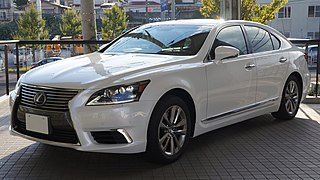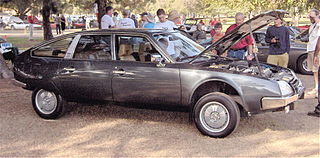
Electronic stability control (ESC), also referred to as electronic stability program (ESP) or dynamic stability control (DSC), is a computerized technology that improves a vehicle's stability by detecting and reducing loss of traction (skidding). When ESC detects loss of steering control, it automatically applies the brakes to help "steer" the vehicle where the driver intends to go. Braking is automatically applied to wheels individually, such as the outer front wheel to counter oversteer, or the inner rear wheel to counter understeer. Some ESC systems also reduce engine power until control is regained. ESC does not improve a vehicle's cornering performance; instead, it helps to minimize the loss of control.

The Toyota Soarer is a personal luxury GT coupé that was produced from 1981 to 2005 by Toyota and was sold in Japan. In Japan, it was available at both Toyota Japan dealerships called Toyota Store and Toyopet Store, and it débuted with the Z10 series, replacing the Toyopet Store exclusive Mark II Coupe, and the Toyota Store exclusive Crown Coupe.

The Lexus LS is a full-size luxury sedan serving as the flagship model of Lexus, the luxury division of Toyota. For the first four generations, all LS models featured V8 engines and were predominantly rear-wheel-drive, with Lexus also offering all-wheel-drive, hybrid, and long-wheelbase variants. The fifth generation changed to using a V6 engine with no V8 option, and only one length was offered.
Hybrid Synergy Drive (HSD) is the brand name of Toyota Motor Corporation for the hybrid car drive train technology used in vehicles with the Toyota and Lexus marques. First introduced on the Prius, the technology is an option on several other Toyota and Lexus vehicles and has been adapted for the electric drive system of the hydrogen-powered Mirai, and for a plug-in hybrid version of the Prius. Previously, Toyota also licensed its HSD technology to Nissan for use in its Nissan Altima Hybrid. Its parts supplier Aisin Seiki Co. offers similar hybrid transmissions to other car companies.

An anti-roll bar is a part of many automobile suspensions that helps reduce the body roll of a vehicle during fast cornering or over road irregularities. It connects opposite (left/right) wheels together through short lever arms linked by a torsion spring. A sway bar increases the suspension's roll stiffness—its resistance to roll in turns, independent of its spring rate in the vertical direction. The first stabilizer bar patent was awarded to Canadian inventor Stephen Coleman of Fredericton, New Brunswick on April 22, 1919.

Active Body Control, or ABC, is the Mercedes-Benz brand name used to describe hydraulic fully active suspension, that allows control of the vehicle body motions and therefore virtually eliminates body roll in many driving situations including cornering, accelerating, and braking. Mercedes-Benz has been experimenting with these capabilities for automobile suspension since the air suspension of the 1963 600 and the hydropneumatic suspension of the 1974 6.9.

The Lexus LX is a full-size luxury SUV sold by Lexus, a luxury division of Toyota since January 1996 having entered manufacture in November 1995. Three generations have been produced, all based heavily on the long-running Toyota Land Cruiser SUVs. The first generation LX 450 started production in 1995 as Lexus' first entry into the SUV market. Its successor, the LX 470, premiered in 1998 and was manufactured until 2007. The latest, third-generation, LX 570 debuted at the New York International Auto Show in April 2007 as a complete redesign for the 2008 model year. The LX name stands for "Luxury Crossover". However, some Lexus importers use the backronymic name, "Luxury Four Wheel Drive".

The Toyota Brevis is a former mid-size luxury sedan introduced in May 2001, that was sold only in Japan.
S-AWC is the brand name of an advanced full-time four-wheel drive system developed by Mitsubishi Motors. The technology, specifically developed for the new 2007 Lancer Evolution, the 2010 Outlander, the 2014 Outlander, the Outlander PHEV and the Eclipse Cross have an advanced version of Mitsubishi Motors' AWC system. Mitsubishi Motors first exhibited S-AWC integration control technology in the Concept-X model at the 39th Tokyo Motor Show in 2005. According to Mitsubishi Motors, "the ultimate embodiment of the company's AWC philosophy is the S-AWC system, a 4WD-based integrated vehicle dynamics control system".

The Driver Monitoring System, also known as Driver Attention Monitor, is a vehicle safety system first introduced by Toyota in 2006 for its and Lexus latest models. It was first offered in Japan on the GS 450h. The system's functions co-operate with the Pre-Collision System (PCS). The system uses infrared sensors to monitor driver attentiveness. Specifically, the Driver Monitoring System includes a CCD camera placed on the steering column which is capable of eye tracking, via infrared LED detectors. If the driver is not paying attention to the road ahead and a dangerous situation is detected, the system will warn the driver by flashing lights, warning sounds. If no action is taken, the vehicle will apply the brakes. This system is said to be the first of its kind.

The Lexus LS (XF40) is the fourth generation of the Lexus LS line of full-size luxury sedans. Lexus debuted the model line at the 2006 North American International Auto Show, with variants including the standard wheelbase LS 460 (USF40) and long wheelbase LS 460 L (USF41); the chassis codes (USF40/USF41) are derived from the fourth generation XF40 platform code and UR series engine designation. In development from 2001, the final design was selected for the V8 models in late 2003, with the hybrid variant's design finalized in 2004. Introduced at the 2006 New York International Auto Show, all-wheel drive hybrid models, the standard wheelbase LS 600h (UVF45) and long wheelbase LS 600h L (UVF46), joined the lineup in the 2008 model year. The LS 460 and LS 460 L models feature a 4.6 L UR series V8 and an 8-speed automatic transmission, while hybrid models are powered by a 5.0 L UR series V8 engine equipped with electric motors, with a continuously variable transmission and all-wheel drive. All-wheel drive versions of the non-hybrid LS 460 (USF45) and LS 460 L (USF46) models were introduced at the 2008 Moscow International Automobile Salon. The XF40 received updates for the 2010 and 2013 model years.

Electronically controlled brake (ECB) developed by Toyota Motor Corporation initially for its hybrid and Lexus models, is the world's first production brake-by-wire braking system. The ECB went on sale in Japan in June 2001, first appearing on the Toyota Estima hybrid, and making its North American debut with the launch of the Lexus RX 400h SUV in April 2005. The ECB is an integral part of the company's Vehicle Dynamics Integrated Management stability control system, by allowing for automatic brake adjustments, which work in conjunction with variable gear-ratio electric power steering systems.

Vehicle Dynamics Integrated Management (VDIM) is an integrated vehicle handling and software control system developed by Toyota. It involves an omnibus computer linkage of traction control, electronic stability control, electronic steering, and other systems, with the intent of improving responsiveness to driver input, performance, and overall safety. The system was first introduced in the Japanese domestic market in July 2004, when Toyota debuted VDIM on the Toyota Crown Majesta. This was followed by the VDIM's export debut on the third generation Lexus GS, which was launched in 2005. VDIM integrates the company's Electronically Controlled Brake (ECB), Anti-Lock Brakes (ABS), Electronic Brakeforce Distribution (EBD), Traction Control (TRC) and Vehicle Stability Control (VSC) active safety systems with the Adaptive Variable Suspension (AVS), Electric Power Steering (EPS) and Variable Gear Ratio Steering (VGRS) systems which previously worked independently using proprietary software. This way all the systems function together rather than the ECU prioritizing which is the most important. VDIM was initially designed for rear-wheel drive cars.

The Lexus GS (S190) is the third generation of the Lexus GS line of mid-size luxury cars. Sold by Lexus since 2005, the line includes multiple V6, V8, and hybrid models. A concept model for the GS line, the LF-S, debuted in late 2003 at the Tokyo Motor Show. The third generation GS first appeared as a pre-production vehicle at the 2004 North American International Auto Show in Detroit with the production version being shown a year later at the 2005 show. The initial lineup featured V6 and V8 engines with rear-wheel drive, and for the first time on a Lexus sedan, the option of all-wheel drive with the V6-powered GS 300 and GS 350 models. The GS 450h performance hybrid joined the lineup in 2006.

The Lexus RX is a mid-size luxury crossover SUV sold since 1998 by Lexus, a luxury division of Toyota. Originally released in its home market of Japan in late 1997 as the Toyota Harrier, export sales began in March 1998 as the Lexus RX. Four generations of the Lexus RX have been produced to date, the first being compact in size, and the latter three classified as mid-size. Both front- and four-wheel drive configurations have been used on the RX series, and several gasoline powertrain options, including V6 engines and hybrid systems, have been offered. In the Lexus model lineup, the RX sits below the larger GX and LX (Known as the Toyota Land Cruiser Prado and the Toyota Land Cruiser body-on-frame SUVs outside North America, and above the smaller NX crossover with a lower displacement inline-4 engine. The RX name stands for Radiant Crossover. It has also been labelled as "Recreation Cross Country" in some markets. The RX's current Toyota counterparts are the Highlander & Kluger; past counterparts were the Harrier and Venza.




















